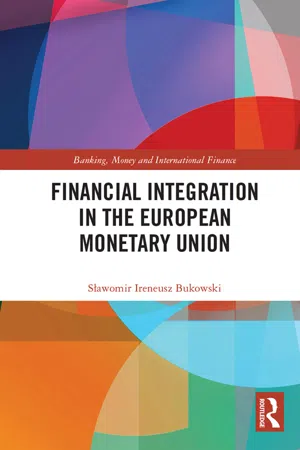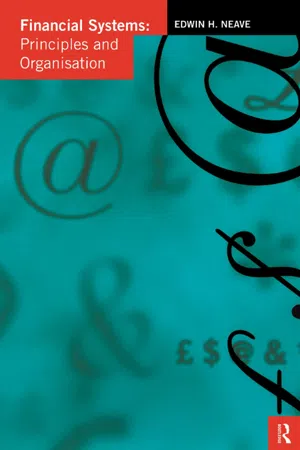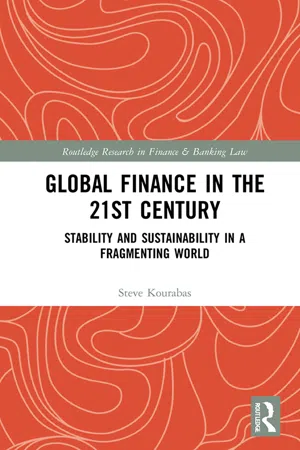Economic Functions of Financial Intermediaries
Financial intermediaries perform several key economic functions, including the transformation of maturities, risk diversification, and the reduction of information costs. By accepting funds from savers and channeling them to borrowers, they help to allocate capital efficiently in the economy. Additionally, financial intermediaries provide liquidity and facilitate the efficient functioning of financial markets.
5 Key excerpts on "Economic Functions of Financial Intermediaries"
- Sławomir Ireneusz Bukowski(Author)
- 2019(Publication Date)
- Routledge(Publisher)
...This type of instrument cannot be created together or individually by savers and investors. This process of added value creation is intensified by competition between the existing financial institutions and those entering the market and introducing financial innovations. Financial institutions must continuously analyze the preferences of the financial market participants and translate these preferences into characteristics of new financial products. An important function of financial intermediation institutions is risk transformation. They create added value by creating financial instruments that absorb risk. In this way, the sector of financial intermediation institutions has evolved into the financial industry sector (see also Allen & Santomero, 1997, pp. 1461–1476; Merton & Bodie, 1995, pp. 1–27; Allen & Gale, 2001, pp. 127–149). As it was mentioned before, the relationship between the role and place in the market of financial intermediation institutions (banks, insurance societies, investment funds, etc.) and the market of financial instruments has changed. In the traditional system, direct customers of financial intermediaries – savings providers and borrowers – were households of lower income and assets and small and medium-size enterprises (SMEs). In the modern system formed as a result of the just-described phenomena related to knowledge-based economy, households and SMEs are customers of financial intermediation institutions that intermediate in investing resources obtained from them in the market of financial instruments (especially those listed in organized markets) and offering products based on exchange listed financial instruments. On the other hand, big companies benefit, to a large extent, from raising financial resources directly in organized capital markets (exchanges). It is a result of the just-described factors that financial intermediation institutions have become financial product providers creating added value...
- eBook - ePub
Financial Systems
Principles and Organization
- Edwin H. Neave(Author)
- 2002(Publication Date)
- Routledge(Publisher)
...Finally, the chapter develops a model explaining how balancing expected profitability against risk can be studied. 15.2 ECONOMICS OF INTERMEDIATION Like any financial firm, intermediaries structure themselves to meet and if possible outperform the competition. Management tries to lead or at least keep abreast of market developments, and at the same time tries to operate as profitably as possible. Meeting these two challenges means that intermediaries adapt their business to changing opportunities. As one example, intermediaries still perform their traditional role of raising funds through deposits and repackaging the funds as loans, but they are increasingly also acting as agents for financings they do not retain on their own books. In performing their traditional roles, intermediaries gather savings deposited in small individual accounts and then lend out the funds in typically larger amounts— an activity sometimes called denomination intermediation. They employ maturity intermediation when they use their short term funds (i.e., funds deposited in chequing and savings accounts) to finance medium term loans. Intermediary operations also transform risk: the depositing client of an intermediary does not face the same default risk as she would if she lent funds directly to one of the intermediary’s clients. The depositor’s risk is related to the diversified risk of the intermediary’s asset portfolio rather than to the credit risk of the borrowing client. Risk is also transformed when portfolios of intermediary loans are securitised: the original loans are repackaged into a diversified portfolio which is then offered as collateral for securities purchased by institutional investors. Despite the advantages of diversification, the uninsured depositor can still face default risk: unsound lending practices can cause an intermediary to fail. Thus when deciding where to place their short term funds, large depositors are wise to take the intermediary default risk into account...
- eBook - ePub
Global Finance in the 21st Century
Stability and Sustainability in a Fragmenting World
- Steve Kourabas(Author)
- 2021(Publication Date)
- Routledge(Publisher)
...Other types of financial intermediaries also perform this economic function, but banks are distinguished by their promise to return savers’ funds at any time, or on demand. 17 This description of banking includes two important concepts: fractional reserve banking and the promise to return deposits. First, the distribution of savings to borrowers refers to what is commonly referred to as ‘ fractional reserve banking.’ To understand the origins of fractional reserve banking we must travel back again to the Italian city-states during Renaissance and Middle Ages Europe and the role of moneychangers and moneylenders. Moneychangers exchanged coins during this period as minting money ceased to be a royal prerogative. 18 They would sit behind their wooden tables (banci) in small town squares across the major Italian city-states, such as the Campo San Giacomo di Rialto in Venice, where they would exchange various coins made of different metals and with different values to facilitate trade between merchants across European regions visiting to take part in trade fairs. 19 Moneychangers also offered their vaults as a storage facility where merchants could store their coins for convenience and safe-keeping during fairs. 20 Moneylenders played an equally important role. As the need for money expanded to meet the demands of economic growth resulting from trade and the need to fund the wars and administrative needs of states and the Church, new techniques were devised to ensure that finance was available to those in need. 21 Moneylenders took advantage of these financial needs to develop bills of exchange that reduced the reliance in economic transactions on coins made of rare precious metals. 22 This facilitated the expansion of monetary supply and encouraged long-distance trade. 23 Bills of exchange alleviated the problem of transferring large quantities of precious metals to complete economic transactions...
- eBook - ePub
Money and Banking
An International Text
- Robert Eyler(Author)
- 2009(Publication Date)
- Routledge(Publisher)
...7 The microeconomics of banking Introduction Like any other business, financial intermediaries have sales, administration, building costs, electricity bills, accounts payable, and office supplies expenses. What makes these businesses different from most others is that the product sold is money. This is true for commercial banks, insurance companies, and investment banks alike. These firms sell services also, but these services are tied to the storing and investing of money in order to make revenue. Financial intermediaries take profits from financial leverage, or in the form of commission as a percent of investor revenue made on a transaction, or both. It is important to view the financial intermediary, especially banks, like any other firm. This chapter’s focus is on the microeconomics of banking decisions, which entails some review of basic price theory from microeconomics. Maximizing profit is assumed to be behind all decisions made by the bank to either approve or reject loan applications, choosing to hire a customer service representative, buying government debt securities, or taking in new deposits. Regulations concerning banking and financial markets are discussed briefly, especially international differences between regulatory environments. We assume here that the profit maximization decisions made by banks are done with the appropriate regulatory environment in mind and acting as constraints on activities. Demand and supply functions are discussed as in any other business. The interaction of the marginal utility and marginal cost for the consumer takes place alongside the interaction of marginal revenue and marginal cost for the financial intermediary. The pursuit of net interest margin lies at the heart of the bank’s profit function. This chapter begins with an overview of demand and supply for deposits to fund the loanable funds market described in Chapter 2. The profit functions and optimality for a bank are also shown...
- eBook - ePub
- Craig E. Carroll(Author)
- 2016(Publication Date)
- SAGE Publications, Inc(Publisher)
...Matthew W. Ragas Matthew W. Ragas Ragas, Matthew W. Financial Intermediaries Financial intermediaries 315 318 Financial Intermediaries Financial intermediaries are a specialized form of information intermediaries that collect, analyze, interpret, and report financial and business information about companies, organizations, and other entities, including states and nations. Financial performance is a widely recognized dimension of corporate reputation. Investors and other financial-oriented stakeholders, at least partially, rely on the perceived superior expertise and access of financial intermediaries, such as Wall Street investment analysts, to interpret the financial performance and fiscal health of companies, organizations, and other entities. As such, the reports, insights, and opinions issued by financial intermediaries influence stakeholder assessments and affect corporate reputations. This entry reviews the major types of financial intermediaries and discusses the uses and varying impacts of information provided by them. Types of Financial Intermediaries There are many different types of financial intermediaries. The influence of these intermediaries has long been an area of interest for corporate reputation and corporate communication scholars. In 1996, leading reputation scholar Charles J. Fombrun noted in his pioneering work, Reputation: Realizing Value From the Corporate Image, that many stakeholders have limited access to the complex inner workings of companies. Even professional investors may have only limited access to the company management and the board of directors...




